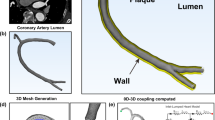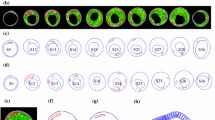Abstract
Atherosclerosis is one of the leading causes of death in the world. In this study, an idealized 2D plaque model based on plaque classification in the coronary artery is developed. When creating the idealized 2D model for each plaque type (fibrocalcic, FC; fibrofatty, FT; calcified fibroatheroma, CaFA; fibroatheroma, FA; calcified thin-cap fibroatheroma, CaTCFA; thin-cap fibroatheroma, TCFA), the cap thickness and stenosis by diameter were set as variables. In order to establish the correlation between each plaque type and plaque rupture, a numerical simulation was performed and the stress and stress gradient were reviewed to analyze the mechanical behavior. Results show that both the TCFA and CaTCFA plaque types, which have the smallest cap thicknesses of the different types of plaque, showed relatively high stress values in the thin membrane when compared with the FT type. The FT type is considered to be relatively stable since it does not have necrotic core or a thin membrane. With a stenosis rate of 50% and a cap thickness of 60 μm, the TCFA and CaTCFA types showed approximately 11 and 110% higher stress values, respectively, and 679 and 1568% higher negative stress gradient values, respectively. In other words, the plaque types with thin caps, which have weak load-bearing capacities, showed high stress values and high negative stress gradients in the radial direction. It is understood that this result could indicate the possibility of plaque rupture.




Similar content being viewed by others
References
Akyildiz AC, Speelman L, van Brummelen H, Gutiérrez MA, Virmani R, van der Lugt A, Van Der Steen A, Wentzel JJ, Gijsen F (2011) Effects of intima stiffness and plaque morphology on peak cap stress. Biomed Eng Online 10:1–13
Bangalore S, Qin J, Sloan S, Murphy SA, Cannon CP, Investigators PI-TT (2010) What is the optimal blood pressure in patients after acute coronary syndromes? Relationship of blood pressure and cardiovascular events in the pravastatin or atorvastatin evaluation and infection therapy-thrombolysis in myocardial infarction (PROVE IT-TIMI) 22 Trial. Circulation 122:2142–2151
Cai JM, Hatsukami TS, Ferguson MS, Small R, Polissar NL, Yuan C (2002) Classification of human carotid atherosclerotic lesions with in vivo multicontrast magnetic resonance imaging. Circulation 106:1368–1373
Calvert PA, Obaid DR, O’Sullivan M, Shapiro LM, McNab D, Densem CG, Schofield PM, Braganza D, Clarke SC, Ray KK (2011) Association between IVUS findings and adverse outcomes in patients with coronary artery disease: the VIVA (VH-IVUS in Vulnerable Atherosclerosis) Study. JACC Cardiovasc Imaging 4:894–901
Chiu T-Y, Chen C-Y, Chen S-Y, Soon C-C, Chen J-W (2012) Indicators associated with coronary atherosclerosis in metabolic syndrome. Clin Chim Acta 413:226–231
Dolla WJS, House JA, Marso SP (2012) Stratification of risk in thin cap fibroatheromas using peak plaque stress estimates from idealized finite element models. Med Eng Phys 34:1330–1338
Falk E, Shah PK, Fuster V (1995) Coron Plaque Disrupt. Circulation 92:657–671
Frauenfelder T, Boutsianis E, Schertler T, Husmann L, Leschka S, Poulikakos D, Marincek B, Alkadhi H (2007) In-vivo flow simulation in coronary arteries based on computed tomography datasets: feasibility and initial results. Eur Radiol 17:1291–1300
Gere JM, Goodno BJ (2009) Mechanics of materials. Cengage Learning Inc, Independence
Gonzalo N, Garcia-Garcia HM, Regar E, Barlis P, Wentzel J, Onuma Y, Ligthart J, Serruys PW (2009) In vivo assessment of high-risk coronary plaques at bifurcations with combined intravascular ultrasound and optical coherence tomography. JACC Cardiovasc Imaging 2:473–482
Goubergrits L, Kertzscher U, Schöneberg B, Wellnhofer E, Petz C, Hege H-C (2008) CFD analysis in an anatomically realistic coronary artery model based on non-invasive 3D imaging: comparison of magnetic resonance imaging with computed tomography. Int J Cardiovasc Imaging 24:411–421
Gradus-Pizlo I, Bigelow B, Mahomed Y, Sawada SG, Rieger K, Feigenbaum H (2003) Left anterior descending coronary artery wall thickness measured by high-frequency transthoracic and epicardial echocardiography includes adventitia. Am J Cardiol 91:27–32
Jang I-K, Tearney GJ, MacNeill B, Takano M, Moselewski F, Iftima N, Shishkov M, Houser S, Aretz HT, Halpern EF (2005) In vivo characterization of coronary atherosclerotic plaque by use of optical coherence tomography. Circulation 111:1551–1555
Karimi A, Navidbakhsh M, Shojaei A, Hassani K, Faghihi S (2014) Study of plaque vulnerability in coronary artery using Mooney-Rivlin model: a combination of finite element and experimental method. Biomed Eng Appl Basis Commun 26(01):1450013
Kim Y-H, Kim J-E, Ito Y, Shih AM, Brott B, Anayiotos A (2008) Hemodynamic analysis of a compliant femoral artery bifurcation model using a fluid structure interaction framework. Ann Biomed Eng 36:1753–1763
Kock SA, Nygaard JV, Eldrup N, Fründ E-T, Klærke A, Paaske WP, Falk E, Kim WY (2008) Mechanical stresses in carotid plaques using MRI-based fluid–structure interaction models. J Biomech 41:1651–1658
Lee S-W, Steinman DA (2007) On the relative importance of rheology for image-based CFD models of the carotid bifurcation. J Biomech Eng 129:273–278
Li Z-Y, Howarth SP, Tang T, Gillard JH (2006) How critical is fibrous cap thickness to carotid plaque stability? A flow–plaque interaction model. Stroke 37:1195–1199
Lindsey JB, House JA, Kennedy KF, Marso SP (2009) Diabetes duration is associated with increased thin-cap fibroatheroma detected by intravascular ultrasound with virtual histology. Circ Cardiovasc Interv 2:543–548
Loree HM, Kamm R, Stringfellow R, Lee R (1992) Effects of fibrous cap thickness on peak circumferential stress in model atherosclerotic vessels. Circ Res 71:850–858
Morlacchi S, Colleoni SG, Cárdenes R, Chiastra C, Diez JL, Larrabide I, Migliavacca F (2013) Patient-specific simulations of stenting procedures in coronary bifurcations: two clinical cases. Med Eng Phys 35:1272–1281
Nair A, Kuban BD, Tuzcu EM, Schoenhagen P, Nissen SE, Vince DG (2002) Coronary plaque classification with intravascular ultrasound radiofrequency data analysis. Circulation 106:2200–2206
Nakamura T, Kubo N, Funayama H, Sugawara Y, Ako J, Si Momomura (2009) Plaque characteristics of the coronary segment proximal to the culprit lesion in stable and unstable patients. Clin Cardiol 32:E9–E12
Nasu K, Tsuchikane E, Katoh O, Vince DG, Virmani R, Surmely J-F, Murata A, Takeda Y, Ito T, Ehara M (2006) Accuracy of in vivo coronary plaque morphology assessment: a validation study of in vivo virtual histology compared with in vitro histopathology. J Am Coll Cardiol 47:2405–2412
Pericevic I, Lally C, Toner D, Kelly DJ (2009) The influence of plaque composition on underlying arterial wall stress during stent expansion: the case for lesion-specific stents. Med Eng Phys 31:428–433. doi:10.1016/j.medengphy.2008.11.005
Raffel OC, Merchant FM, Tearney GJ, Chia S, Gauthier DD, Pomerantsev E, Mizuno K, Bouma BE, Jang I-K (2008) In vivo association between positive coronary artery remodelling and coronary plaque characteristics assessed by intravascular optical coherence tomography. Eur Heart J 29:1721–1728
Rambhia S, Liang X, Xenos M, Alemu Y, Maldonado N, Kelly A, Chakraborti S, Weinbaum S, Cardoso L, Einav S (2012) Microcalcifications increase coronary vulnerable plaque rupture potential: a patient-based micro-CT fluid–structure interaction study. Ann Biomed Eng 40:1443–1454
Sironi A, Petz R, De Marchi D, Buzzigoli E, Ciociaro D, Positano V, Lombardi M, Ferrannini E, Gastaldelli A (2012) Impact of increased visceral and cardiac fat on cardiometabolic risk and disease. Diabet Med 29:622–627
Tang D, Yang C, Zheng J, Woodard PK, Sicard GA, Saffitz JE, Yuan C (2004) 3D MRI-based multicomponent FSI models for atherosclerotic plaques. Ann Biomed Eng 32:947–960
Teng Z, Sadat U, Li Z, Huang X, Zhu C, Young VE, Graves MJ, Gillard JH (2010) Arterial luminal curvature and fibrous-cap thickness affect critical stress conditions within atherosclerotic plaque: an in vivo MRI-based 2D finite-element study. Ann Biomed Eng 38:3096–3101
Torii R, Wood NB, Hadjiloizou N, Dowsey AW, Wright AR, Hughes AD, Davies J, Francis DP, Mayet J, Yang GZ (2009) Fluid–structure interaction analysis of a patient-specific right coronary artery with physiological velocity and pressure waveforms. Commun Numer Methods Eng 25:565–580
Toussaint JF, LaMuraglia GM, Southern JF, Fuster V, Kantor HL (1996) Magnetic resonance images lipid, fibrous, calcified, hemorrhagic, and thrombotic components of human atherosclerosis in vivo. Circulation 94:932–938
Vandeghinste B, Trachet B, Renard M, Casteleyn C, Staelens S, Loeys B, Segers P, Vandenberghe S (2011) Replacing vascular corrosion casting by in vivo micro-CT imaging for building 3D cardiovascular models in mice. Mol Imaging Biol 13:78–86
Yang C, Bach RG, Zheng J, Naqa IE, Woodard PK, Teng Z, Billiar K, Tang D (2009) In vivo IVUS-based 3-D fluid–structure interaction models with cyclic bending and anisotropic vessel properties for human atherosclerotic coronary plaque mechanical analysis. IEEE Trans Biomed Eng 56:2420–2428
Author information
Authors and Affiliations
Corresponding author
Ethics declarations
Acknowledgements
This research was supported by the Chung-Ang University Graduate Research Scholarship in 2016 and Basic Science Research Program through the National Research Foundation of Korea (NRF) funded by the Ministry of Education (No. 2015R1D1A1A01057341).
Rights and permissions
About this article
Cite this article
Lee, W., Choi, G.J. & Cho, S.W. Numerical study to indicate the vulnerability of plaques using an idealized 2D plaque model based on plaque classification in the human coronary artery. Med Biol Eng Comput 55, 1379–1387 (2017). https://doi.org/10.1007/s11517-016-1602-x
Received:
Accepted:
Published:
Issue Date:
DOI: https://doi.org/10.1007/s11517-016-1602-x




